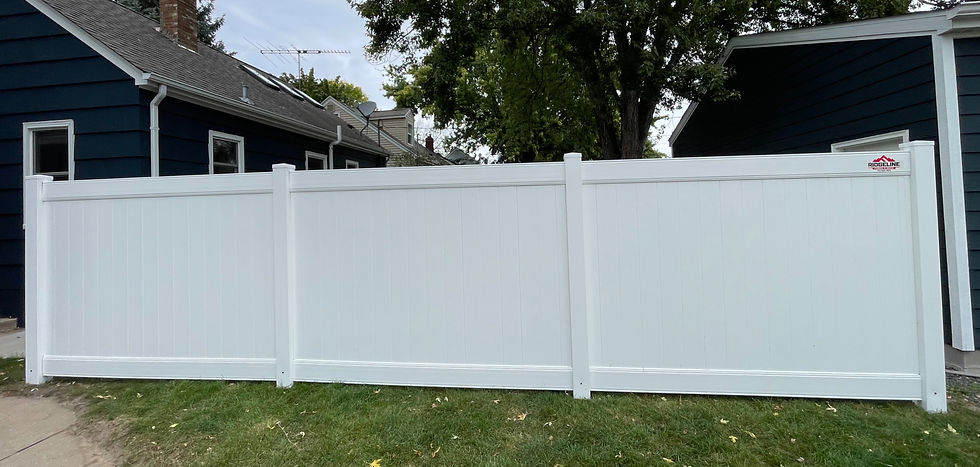Do Fence Boards Shrink Over Time?
- Maxwell Wiczek
- Mar 14
- 2 min read
Updated: Apr 15

When installing a wooden fence, one of the most common concerns homeowners have is whether fence boards will shrink over time. The answer is yes, wood naturally shrinks as it dries, which can lead to gaps, warping, and other structural issues.
However, the extent of shrinkage depends on wood type, climate, and proper treatment.
Why Do Fence Boards Shrink Over Time?
Wood is a porous material that absorbs and releases moisture. Freshly cut or pressure-treated wood contains high moisture content, and as it dries, the fibers contract—causing shrinkage. This process can lead to:
• Gaps between boards as they pull apart
• Warping, cupping, or twisting due to uneven drying
• Weakened structural integrity over time
Factors That Affect Wood Shrinkage
1. Type of Wood Used
The type of wood you choose has a big impact on how much it will shrink:
• Cedar & Redwood: Naturally resistant to moisture changes, less prone to shrinking and warping. Ideal for long-lasting fences.
• Pressure-Treated Pine: An affordable option, but tends to shrink and warp more quickly due to the high moisture content in treatment.
• Hardwoods (Oak, Ipe, Teak): Denser and less likely to shrink, but they are expensive and harder to work with.
2. Climate & Weather Conditions
• Hot & Dry Climates: Wood dries faster, causing more shrinkage and potential cracking.
• Humid or Rainy Climates: Wood expands when wet and contracts when dry, leading to fluctuating gaps in the fence.
• Seasonal Changes: Extreme temperature shifts cause cycles of expansion and contraction, stressing the wood.
3. Treatment & Sealing
Proper treatment can slow down shrinkage and extend the life of your fence:
• Sealing the wood with a quality stain or sealant helps lock in moisture and prevent excessive drying.
• Painting the fence provides a protective barrier against weather changes.
• Allowing pressure-treated wood to dry before installation (typically 4–8 weeks) reduces shrinkage after installation.
How to Prevent Fence Board Shrinkage Issues
While wood shrinkage is a natural process, you can take steps to minimize its effects:
✔ Choose a stable wood species like cedar or redwood
✔ Allow pressure-treated wood to dry before installing
✔ Space boards properly to account for shrinkage
✔ Apply a high-quality wood sealant to protect against moisture changes
✔ Inspect and maintain your fence yearly to catch early signs of warping or damage
Final Thoughts
Yes, fence boards do shrink over time, but with the right wood choice, proper treatment, and regular maintenance, you can minimize gaps and warping. If you’re installing a new fence, working with a professional fencing company like Ridgeline Fence and Deck ensures you get a durable, long-lasting fence built with shrinkage in mind.
Contact us today and get a free estimate and expert guidance!




Best Gold Mutual Fund are becoming a reliable choice for investors who want to protect their wealth from market ups and downs. These funds allow easy investment in gold without the need to buy physical gold. They are managed by professionals and offer good liquidity with lower risks compared to direct gold purchases. For anyone looking to diversify their portfolio and add stability, investing in the best gold mutual funds can be a smart and convenient option for long-term growth.
Investing in Best Gold Mutual Funds in India has become a smart way to add stability to a portfolio. It offers the benefit of investing in gold without the need to hold it physically. These funds are ideal for balancing risk during uncertain market conditions. Many investors choose them to protect their wealth from inflation and currency fluctuations. Focusing on factors like fund performance, expense ratio, and investment horizon can help in making better decisions for long-term financial growth.
https://veterinarypracticetransition.com/author/prestigesavon/
https://ugetube.com/@prestigesavon
https://tuscl.net/member/856875
https://tap.bio/@prestigesavon/cards/999970
https://slideslive.com/fva6elk9rqfb?tab=about
https://slatestarcodex.com/author/prestigesavonn/
https://sketchersunited.org/users/271359
https://qooh.me/prestigesavon
https://prestigesavon.hotglue.me/
https://postr.yruz.one/profile/prestigesavon
https://www.cureus.com/users/941749-jyoti-sharma
https://www.cems-sc.org/user-profile/userid/28099
https://www.blockdit.com/users/689d9075a2fec0801b0be09f
https://www.battlecam.com/profile/info/4485916
https://www.are.na/prestige-avon/prestige-avon-enclmkk6eju
https://www.aphorismsgalore.com/users/prestigesavon
https://www.abclinuxu.cz/Profile/101080
https://www.24liveblog.com/user/prestigesavon
https://web.trustexchange.com/company.php?q=www.prestigeavon.info
https://vozer.net/members/prestigesavon.47427/
https://www.jetphotos.com/photographer/491896
https://www.investagrams.com/Profile/lizaguptaa
https://www.in-pocasi.cz/uzivatele/avonprest-147952/
https://www.eventbookings.com/b/member/profile/a2caa6b7-1405-41d6-88b4-14d2bad620cf
https://www.empregosaude.pt/en/author/prestigesavon/
https://www.doyoubuzz.com/prestige-avon
https://www.dnxjobs.de/users/prestigesavon
https://www.digitalinfrastructure.ie/profile/prestigesavon17014/profile
https://www.designspiration.com/prestavon/saves/
https://www.darkml.net/bbs/home.php?mod=space&uid=8161495&do=profile&from=space